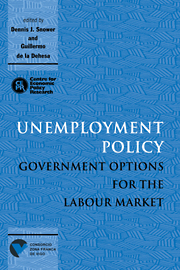Book contents
- Frontmatter
- Contents
- List of figures
- List of tables
- Preface
- Acknowledgements
- List of conference participants
- 1 Introduction
- PART ONE GENERAL POLICY ISSUES
- PART TWO DEMAND MANAGEMENT AND SUPPLY-SIDE POLICY
- 4 The role of demand-management policies in reducing unemployment
- Discussion
- 5 Edmund Phelps' theory of structural slumps and its policy implications
- Discussion
- Discussion
- PART THREE SUBSIDISING EMPLOYMENT AND TRAINING
- PART FOUR LABOUR MARKET REGULATIONS
- PART FIVE POLICY, JOB REALLOCATION AND THE UNEMPLOYMENT–PRODUCTIVITY RELATION
- PART SIX COMPARING UNEMPLOYMENT POLICIES
- Index
4 - The role of demand-management policies in reducing unemployment
Published online by Cambridge University Press: 07 September 2010
- Frontmatter
- Contents
- List of figures
- List of tables
- Preface
- Acknowledgements
- List of conference participants
- 1 Introduction
- PART ONE GENERAL POLICY ISSUES
- PART TWO DEMAND MANAGEMENT AND SUPPLY-SIDE POLICY
- 4 The role of demand-management policies in reducing unemployment
- Discussion
- 5 Edmund Phelps' theory of structural slumps and its policy implications
- Discussion
- Discussion
- PART THREE SUBSIDISING EMPLOYMENT AND TRAINING
- PART FOUR LABOUR MARKET REGULATIONS
- PART FIVE POLICY, JOB REALLOCATION AND THE UNEMPLOYMENT–PRODUCTIVITY RELATION
- PART SIX COMPARING UNEMPLOYMENT POLICIES
- Index
Summary
Macroeconomic policy has two roles in reducing unemployment: over the short term it limits cyclical fluctuations in output and employment; and over the longer term it should provide a framework, based on sound public finances and price stability, to ensure that growth of output and employment is sustainable, inter alia through adequate levels of savings and investment.
This quotation appears at the beginning of the Policy Recommendations section of the OECD's Jobs Study (OECD, 1994a). However of the 59 separate recommendations only three concern macroeconomic policies, and only 10 per cent of the background analysis is concerned with macroeconomic issues. The three specific macroeconomic recommendations are: (i) maintaining demand at a level appropriate for achieving non-inflationary growth, (ii) fiscal consolidation, (iii) improving the mix of public spending and taxation (as much a microeconomic measure in any case). Likewise most of the contributions in this volume concentrate on structural issues connected with labour markets rather than traditional macroeconomic questions.
Let me state clearly at the outset that I do not wish to argue that this emphasis on the supply side is mistaken. While it is almost certainly the case that adverse demand shocks have played at least some role in pushing European unemployment to its present levels, the scope for more expansionary macroeconomic policies alone to reverse the trend are distinctly limited, for reasons that will be discussed below.
- Type
- Chapter
- Information
- Unemployment PolicyGovernment Options for the Labour Market, pp. 83 - 111Publisher: Cambridge University PressPrint publication year: 1997
- 6
- Cited by



